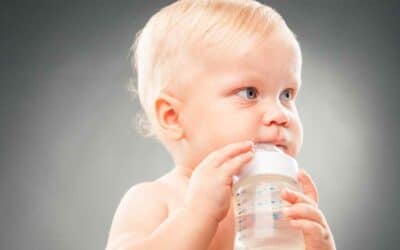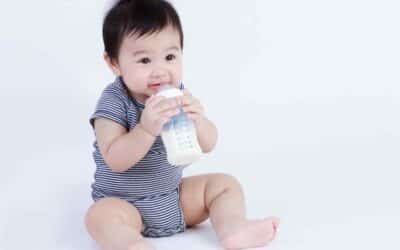From the moment they first open their eyes, the well-being of our little ones becomes a paramount concern for every parent. As their tiny bodies rapidly grow and develop, providing them with the right nutrition becomes a critical task. For parents who rely on baby formula, this means not only selecting the right product but also ensuring that it’s prepared correctly. The article underscores a delicate dance of precision and care when mixing baby formula ratios with distilled water.
Whether you’re a new parent or a caregiver, the water used and the exact ratio of formula are more than just guidelines; they’re fundamental building blocks of your baby’s health. This article delves deep into the art and science of preparing baby formula with distilled water, offering insights, guidance, and the peace of mind that comes from knowing you’re giving your baby the very best start in life. Let’s embark on this enlightening journey together, ensuring every bottle crafted is, indeed, the perfect mix.
Understanding Baby Formula Ratios
Every parent aims to provide the best nutrition for their newborn. For those relying on baby formula, ensuring it’s prepared accurately is crucial. Understanding the intricacies of baby formula ratios is essential for the health and well-being of your infant.
The Importance of Adhering to Manufacturer’s Guidelines:
Manufacturers put a lot of research into the optimal composition of infant formula. Their guidelines ensure that the baby drinks a formula that mimics breast milk as closely as possible, in terms of nutritional value. Always consult the formula container for specific instructions. Whether it’s powdered formula, liquid formula, or concentrated formulas, each comes with its unique preparation method.
1. Water for Baby Formula: There’s a lot of debate surrounding the best water for baby formula. While tap water is commonly used, some areas might have water that contains too much fluoride or potential lead exposure, making it unsuitable for babies. Cold tap water should be avoided due to potential bacterial contamination. On the other hand, bottled water might contain too much fluoride, and distilled or purified water, like nursery water or water treated through reverse osmosis, lacks the essential minerals. It’s advisable to use boiled water or filtered tap water for baby formula preparation. Let the boiled water cool down before using it to make baby formula. Also, ensure it’s been at a rolling boil for at least a minute to kill any bacteria. After this, cooled boiled water can be used.
2. Preparing the Formula: Always measure the powder formula or concentrated liquid accurately using the scoop or measurements provided. Avoid the guesswork. The right amount ensures that the baby receives adequate nutrition. When making baby formula, first add water to the baby bottle, then add the formula. For powdered formulas, the formula powder should be levelled off using a knife or the leveller provided.
3. Formula Temperature: Baby formula doesn’t have to be warm, but some infants prefer it close to body temperature. To heat formula, place the prepared formula bottle in a bowl of warm water or use a bottle warmer. Test the formula’s temperature by placing a few drops on your wrist; it should feel lukewarm. Avoid using a microwave, as it can heat formula unevenly, creating hot spots that can burn the baby’s mouth.
Potential Risks of Over-dilution and Under-dilution:
1. Over-dilution: Adding too much water or too little formula can be dangerous. It can lead to water intoxication, which is when the balance of electrolytes in the baby’s body gets disrupted. Symptoms might include irritability, drowsiness, and in severe cases, seizures. Premature infants are at a higher risk due to their underdeveloped kidneys. Over-dilution also means the baby might not get enough nutrition, which can impact growth and development.
2. Under-dilution: Using too much formula or too little water can lead to dehydration. Signs include dark urine, fewer wet diapers, and drowsiness. Always check the ratio guidelines on the formula container to avoid such issues.
The Choice of Distilled Water
In the realm of baby formula preparation, the choice of water can be just as critical as the formula itself. With numerous options available, distilled water emerges as a leading contender. Let’s delve into its definition, benefits, and how it stands in comparison to the ubiquitous tap water.
Definition and Benefits of Using Distilled Water:
Distilled water is produced by boiling water and then condensing the steam back into a liquid. This process removes most, if not all, of its impurities and minerals.
Benefits:
1. Purity: When you prepare baby formula using distilled water, you’re minimizing the risk of any unwanted contaminants.
2. Consistency: Distilled water offers a consistent water quality, which can be especially valuable if you’re unsure about the quality of your local water supply or if you frequently travel.
3. No Fluoride: Unlike some tap or fluoridated water sources, distilled water lacks fluoride. While fluoride can benefit dental health in older children and adults, it’s best to consult with a board certified pediatrician about its appropriateness for infants.
Comparison of Distilled Water vs. Tap Water:
1. Minerals: While tap water often contains minerals beneficial for adults, these can sometimes pose issues for babies when mixed with baby formulas. Distilled water, on the other hand, lacks these minerals, offering a blank slate that lets the formula milk provide the needed nutrients.
2. Contaminants: Tap water, depending on the local water supply, might contain contaminants. The most concerning for babies is the potential lead exposure. Using distilled water avoids such potential health risks.
3. Potential Risks: Warm tap water can sometimes harbor contaminants, which is why it’s often recommended to use cold water if you’re using tap. However, even cold water should be brought to a boil and then cooled before using it to make baby formula. Distilled water’s distillation process essentially performs this boiling step in advance, making it a safer, ready-to-use option. However, if you choose to warm formula prepared with distilled water for your baby’s preference, ensure the warmed formula is at the right temperature by testing a few drops on your wrist.
Potential Issues and Solutions
Parenting is a journey fraught with learning curves and unforeseen challenges. Among the earliest trials that new parents often face is mastering the art of bottle feeding. From ensuring the right mix to addressing typical concerns, the process can sometimes seem overwhelming. Let’s unpack some potential issues related to infant formula and their solutions.
Recognizing When The Formula Doesn’t Mix Well: Signs and Troubleshooting
1. Undissolved Lumps: If after shaking the baby bottle, you still find lumps of powder formula, it’s a sign that the formula hasn’t mixed well.
– Solution: Ensure the water (whether it’s tap water, spring water, or bottled water) is at the right temperature, typically lukewarm. Hot water can sometimes cause the powdered formula to clump. Moreover, always add water first, followed by the specified amount of formula powder.
2. Separation or Settling: Sometimes, after letting a prepared formula sit, you might notice some settling or separation.
– Solution: Gently swirl or shake the baby’s bottle before feeding. If the issue persists, consider checking the formula’s expiration date and storage conditions.
3. Discoloration: The prepared formula should have a consistent color. Any discoloration might be a sign of contamination or an issue with the water used.
– Solution: Always use safe water for baby formula. If using tap water, consider boiling it first to remove potential contaminants. If you’re worried about potential lead exposure, bottled or filtered water can be a safer alternative.
Addressing Common Parental Concerns
1. Formula Temperature: Many parents worry about the ideal temperature for the baby’s formula.
– Solution: While many babies prefer lukewarm formula that mimics breast milk’s natural warmth, room temperature or even cold formula from the refrigerator is also safe. It’s essential to avoid very hot water, which can degrade the nutrients in the formula.
2. Storing Prepared Formula: “How long can I keep the mixed formula?” is a common question.
– Solution: If your baby doesn’t finish a bottle, store the remaining liquid in the refrigerator and use it within one hour. Any formula left out for more than one hour should be discarded.
3. Water Safety: Given the importance of water in mixing formula, parents are often concerned about its quality.
– Solution: Boiling tap water for a minute and then letting it cool can ensure its safety. Bottled water, specifically labeled for infant use, can be another option, but it’s best to consult with a pediatrician first.
Feeding Tips and Tricks
Feeding your infant can be both a joyous and daunting task, especially for new parents. While the foundation of the feeding process is the baby formula, there are nuances that can greatly influence the experience for both you and your little one. From temperature preferences to understanding if your baby is satiated, this column offers invaluable insights to make each feeding session smooth and effective.
Temperature Checks and How to Heat the Mixed Formula
1. Baby’s Preference: Much like adults, babies too have temperature preferences. Some may prefer their formula warm, mimicking the natural warmth of breast milk, while others might be content with room temperature.
2. Heating the Formula: If you decide to heat the baby’s formula, the safest method is to place the baby bottle in a bowl of warm tap water. Alternatively, you can use a designated bottle warmer. Always avoid using a microwave, as it can cause uneven heating and create hot spots in the formula, which can burn your baby’s mouth.
3. Testing the Temperature: Before feeding, test the formula’s temperature by dropping a little on your wrist. It should feel lukewarm and not hot.
Signs Your Baby is Getting the Right Amount and Concentration
1. Regular Weight Gain: A consistent increase in weight is one of the most reliable signs your baby is getting enough formula. Regular check-ins with a pediatrician can help monitor this.
2. Satisfaction After Feeding: If your baby seems content and relaxed after feeding, it’s a good indicator they’re satiated.
3. Alertness: A well-fed baby is typically alert during their wakeful hours.
4. Avoid over-concentration: Ensure you’re mixing powder formula as per the manufacturer’s guidelines. Using too much formula powder or not enough water can lead to electrolyte imbalance. Similarly, too much water can dilute the formula, depriving your baby of necessary nutrients.
5. Number of Wet Diapers: An average of six to eight wet diapers a day indicates your baby is well-hydrated.
6. Store Unused Formula Correctly: If you’ve prepared more infant formula than your baby can consume in one go, remember that any unused portion of the mixed formula should be refrigerated and used within one hour or discarded.
Conclusion
Navigating the early stages of parenthood is often likened to charting unknown waters, with each decision carrying the weight of ensuring your baby’s well-being. Among these, mastering the art of preparing baby formula stands paramount. Understanding the intricacies of mixing formula, particularly with distilled water, goes beyond just feeding – it’s about offering optimal nutrition, safety, and comfort to your little one.
As we’ve journeyed through the nuances of crafting that perfect mix, remember that consistency, attention to detail, and adhering to guidelines are your best allies. Yet, amidst all the ratios and guidelines, never forget the immeasurable love and bond that each feeding session nurtures. As you confidently mix each bottle, know that you’re not just nourishing your baby’s body, but also building a foundation of trust and care that will last a lifetime.
If you found this article helpful, please let us know by commenting below. If you have any questions, please don’t hesitate to ask!



